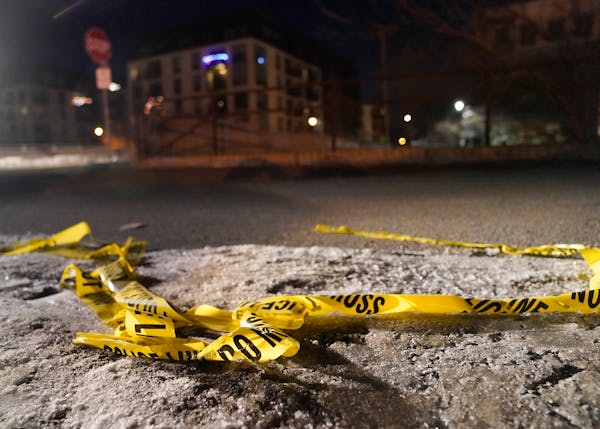Carmen Arett's house on 17th Avenue S. in Minneapolis caught fire last summer while she was sleeping.
By the time Arett woke up, flames were licking up the side of the house and poking through the roof. She heard a loud bang, and then the wall was engulfed. She and her roommate, mother and dog all got out, but her house of 26 years was destroyed, along with the house next door. It had been a dry summer, and the inferno spread "fast and furious," Arett said.
Officials deemed the fire an arson. But 10 months later, the case remains unsolved, with no suspects, no arrests — and not much hope for Arett, who has since moved out of town, frustrated after her boarded-up house was repeatedly broken into and her remaining belongings vandalized.
Her case is not unique; in recent years, the vast majority of arsons have gone unsolved in Minneapolis.
A Star Tribune review of Minneapolis police data found that in 2022, 104 fires were deemed arson, leading to five arrests and four suspects charged. In 2023 there were 134 arsons, 10 arrests and three suspects charged. One reason: For months during that period, the Minneapolis Police Department did not have an arson investigator.
Staffing is a big part of why most arsons go unsolved, said Brian Feintech, spokesperson for the city's Office of Community Safety. The Minneapolis Fire Department has four investigators who determine whether suspicious fires can be called arsons. The cases are then sent to the police department, which has just one investigator to find who might be responsible.
The current MPD arson investigator was hired last spring after an eight- or nine-month period when the position sat vacant, said Feintech. "A lot of things are like that. Either nobody wants that job, or there are certain qualifications you have to have," he said. "For a good portion of 2022 and early 2023, there was no MPD arson investigator."
The Minneapolis Police Department has seen a significant decline in staffing overall in recent years. Last month, the MPD had 560 sworn staff with 21 on long-term leave — down 40% compared to 2020.
The few charges that have come of recent arson investigations were mostly for crimes caught on tape — such as a 2022 case where a 24-year-old woman was caught on surveillance cameras carrying a gas can into the building where a man she knew was staying. Other arrests happened in cases with readily apparent suspects, including two 2022 incidents involving men who set their ex-partners' vehicles on fire.
In the spring of 2022, a 28-year-old arsonist terrorized people across the Howe neighborhood when he set a garage on fire, entered a woman's home, poured gas on the floor of a populated bus and started a fire in an ambulance. Late last year, a 33-year-old man was charged with first-degree murder for deliberately setting fire to the tent of a double-amputee living near Target Field, killing him.
Neighborhood impact
City Council Member Jason Chavez, who represents south-central Minneapolis neighborhoods including Powderhorn Park, Phillips and Corcoran, said he sometimes hears constituents speculating about why houses are burned down — and whether homeless people are at fault, or if it was a hate crime or personal attack.
In 2022, there was a three-house conflagration on the 2800 block of 14th Avenue S., and while there were rumors that someone associated with a nearby encampment targeted those homes, the fire department classified the fires as "undetermined." When cases like that aren't resolved, it creates tension and stress in neighborhoods, Chavez said.
"We need to be, one, making sure that we as a city are providing enough support for investigators to do their job," he said. "The other part is where these [arsons] are happening the most, I would start there in doing proactive prevention. … There's a lot of poverty in these areas, and we need to make sure that we can figure out how we can support these residents."
Data from the city shows that a few neighborhoods, including one in Chavez' ward, have dealt with an outsized share of deliberately set fires. Last year, the East Phillips neighborhood led the city with eight arsons. In 2022, the Hawthorne neighborhood in Minneapolis' Near North area had the highest number, also with eight.
The fire that destroyed Arett's house also burned the house of her neighbor, Schuyler Sellars. He worried his house had been intentionally set on fire because, as the vice president of the East Phillips neighborhood association at the time, he had been somewhat outspoken about the area's perennial problems with homelessness, addiction, break-ins and people defecating in the nearby community garden.
Arett doesn't think that's the case; she's pretty sure the fire started at her house. Neither neighbor got a resolution, and no one was ever held accountable.
After the fire, Sellars was forced to bounce between living in hotels, an Airbnb and a camper parked behind the ruins of his house.
Arett said she filed several police reports about the squatters in her burned-out home but didn't get much of a response and eventually gave up.
"After a while, you get to being quiet when you don't have any other resources to complain," she said. "We just keep on hoping something gets better, but until the powers that be want to put things in place to help, I don't see it getting much better."
Star Tribune data reporter Jeff Hargarten and staff writer Liz Sawyer contributed to this story.

Want to share info with the Star Tribune? How to do it securely

'Safe recovery sites' would offer syringes, naloxone and more to people using drugs. The plan could be in peril.
New Minnesota GOP leaders seek peace with party's anti-establishment wing

Who is Republican Lisa Demuth, Minnesota's first House speaker of color?

